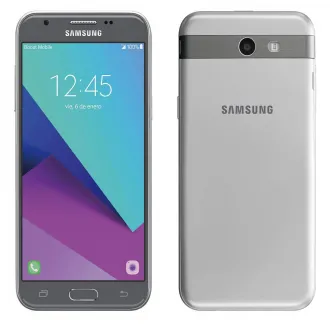Samsung phones like the Samsung Galaxy J3 are Android based phones that use ADB drivers to interface with the phone to access advanced features that an advanced user of a phone may want to access. Changing the operating system/Custom ROM is one of the primary reasons to use it. For example, Linage OS which is a clean version of Android that has bloatware removed from it or Ubuntu touch which is a port of Ubuntu for mobile phones. Whatever you are going to do via the USB port that isn’t just accessing photos or other content that would be accessible with standard mass storage USB drivers will be done with the ADB interface, and whatever drivers are needed for your chipset.
Network: Technology:
GSM / HSPA / LTE
Launch: Announced: 2016, March 31
Status: Available. Released 2016, May 06
Body: Dimensions: 142.3 x 71 x 7.9 mm (5.60 x 2.80 x 0.31 in)
Weight: 138 g (4.87 oz)
Build: Glass front (Asahi Dragontrail), plastic back, plastic frame
SIM: Single SIM (Micro-SIM) or Dual SIM (Micro-SIM, dual stand-by)
Install Instructions
Step 1 — Download and extract the Android USB Driver to your PC.
Step 2 — Click Start (Windows) -> Control Panel -> Device Manager (Select Device Manager).
Step 3 — On the Device Manager window find and click on computer name to select Add legacy hardware.
Step 4 — Select Next
Step 5 — Selext Install the hardware that I manually select from a list (Advanced), and click the Next
Step 6 — Select Show All Devices afterward click Next button again.
Step 7 — Click the Have Disk button.
Step 8 — Click Browse button to find the extracted Android ADB Driver -> android_winusb.inf and click on Open.
Step 9 — Click OK.
Step 10 — Now select the Android ADB Interface -> click Next button.
Step 11 — Click Next button again.
Step 12 — Windows Security box will appear, to confirm whether you really want to install the Android USB Driver, so just choose the Install this driver software anyway.
Step 13 — Once you clicked the Finish button, then repeat from step 2 to choose Android Composite ADB Interface.
Step 14 - Done.
Show: Full Specs/Additional configurations
Network: Technology:
GSM / HSPA / LTE
Launch: Announced: 2016, March 31
Status: Available. Released 2016, May 06
Body: Dimensions: 142.3 x 71 x 7.9 mm (5.60 x 2.80 x 0.31 in)
Weight: 138 g (4.87 oz)
Build: Glass front (Asahi Dragontrail), plastic back, plastic frame
SIM: Single SIM (Micro-SIM) or Dual SIM (Micro-SIM, dual stand-by)
Nano-SIM (USA models only)
Display: Type: Super AMOLED
Size: 5.0 inches, 68.9 cm2 (~68.2% screen-to-body ratio)
Resolution: 720 x 1280 pixels, 16:9 ratio (~294 ppi density)
Protection: Asahi Dragontrail Glass
Platform: OS: Android 5.1.1 (Lollipop) or Android 6.0 (Marshmallow), upgradable to 7.1.1 (Nougat)
Chipset: Spreadtrum SC9830
Exynos 3475 Quad (28 nm) - USA
CPU: Quad-core 1.5 GHz Cortex-A7
Quad-core 1.3 GHz Cortex-A7 - USA
GPU: Mali-400
Mali-T720 - USA
Memory: Card slot: microSDXC (dedicated slot)
Internal: 8GB 1.5GB RAM, 16GB 2GB RAM
: eMMC 4.5
Main Camera: Single: 8 MP, f/2.2, AF
5 MP, f/2.2, AF - USA
Features: LED flash, HDR
Video: 720p@30fps
Selfie camera: Single: 2 MP (USA)
5 MP, f/2.2 (all other regions)
Video: 720p@30fps
Sound: Loudspeaker: Yes
3.5mm jack: Yes
Comms: WLAN: Wi-Fi 802.11 b/g/n, Wi-Fi Direct, hotspot
Bluetooth: 4.0/4.1, A2DP, LE
GPS: Yes, with A-GPS, GLONASS
NFC: Yes (market dependent)
Radio: FM radio, RDS, recording (market dependent)
USB: microUSB 2.0, USB On-The-Go
Features: Sensors: Accelerometer, proximity
Battery: Type: Li-Ion 2600 mAh, removable
Stand-by: Up to 349 h
Talk time: Up to 22 h
Music play: Up to 77 h
Misc: Colors: White, Black, Gold
Models: SM-J320H, SM-J3109, SM-J320FN, SM-J320P, SM-J320F, SM-J320M, SM-J320Y, SM-J320A, SM-J320G, SM-J327T1, SM-J320V, SM-J320YZ, SM-J320W8, SM-J320ZN, SM-J320N0
SAR: 1.17 W/kg (head) 1.12 W/kg (body)
SAR EU: 0.48 W/kg (head) 0.42 W/kg (body)
